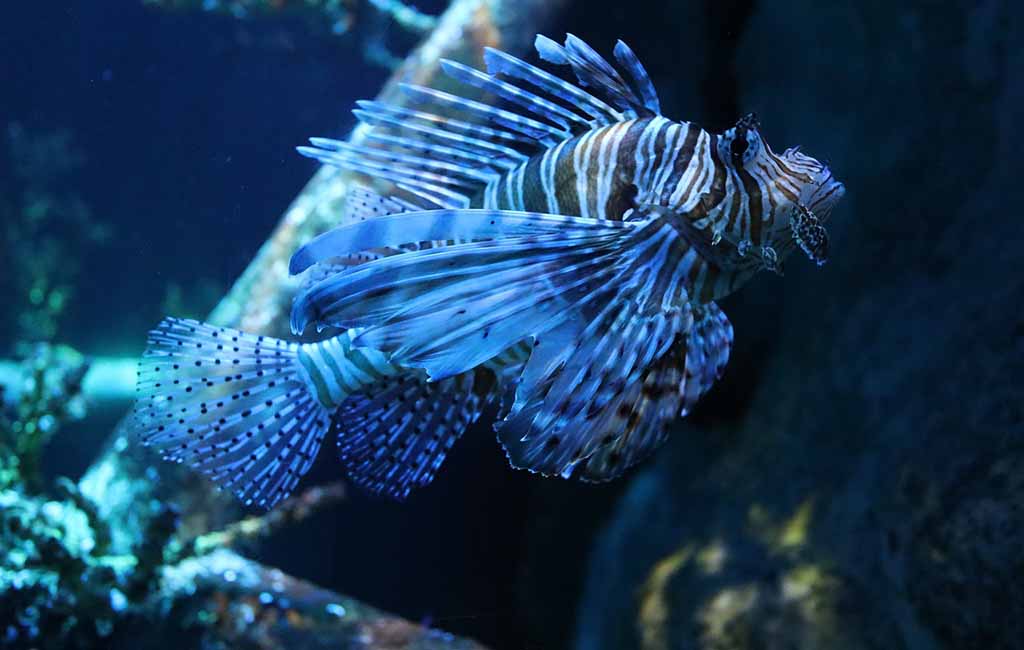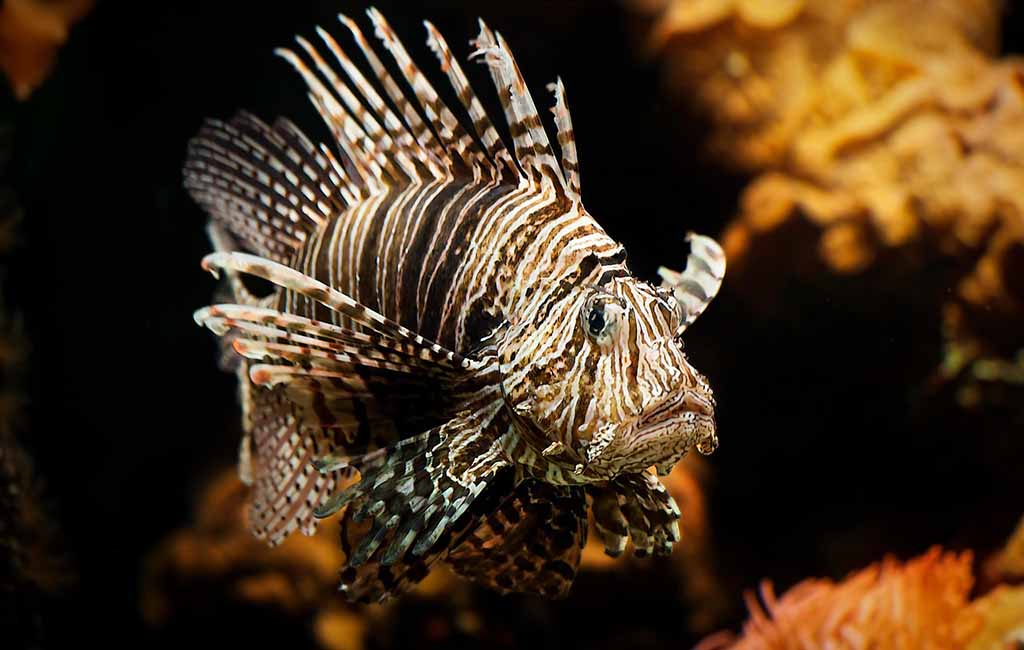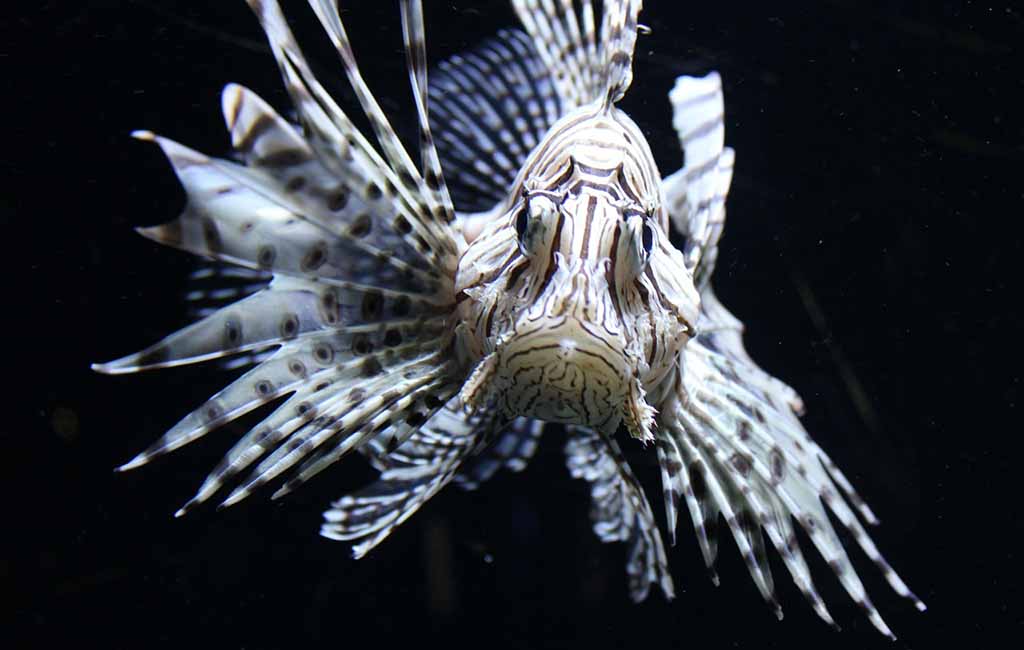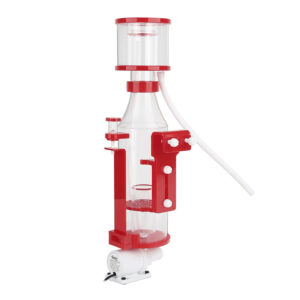Lionfish from the Pterois genus display eye-catching striped patterns combined with dangerous venomous spines as their physical traits. The vibrant colors of Lionfish warn all predators about their dangerous nature because they contain toxic chemicals. The Indo-Pacific home region of these predatory fish has now led to their invasive presence in Atlantic Ocean waters, which creates substantial destruction for marine ecosystems.
Content Table
This article examines how lionfish affect coral reefs while exploring their distinctive characteristics and control measures put in place to restrict their expansion. Conservationists implement removal programs and culinary initiatives to control their populations. Knowledge of their behavior patterns and life span helps maintain protection over marine biodiversity.

The lionfish genus
Lionfish Genus
Lionfish exist within two main species of their Pterois genus: Pterois volitans (red lionfish) and Pterois miles (devil firefish). They have two distinct features that include their extended fan-shaped pectoral fins along poisonous dorsal spines for protection and predation.
Lionfish inhabit warm tropical marine ecosystems and maintain their presence in coral reefs and lagoons alongside rocky depressions because their striped body pattern makes them blend into corals. The combination of their aggressive, predatory nature and fast reproduction makes lionfish a dominant force when they expand to new territories.
The establishment of lionfish populations in alien territories creates environmental challenges because their absence of natural predators allows them to destroy young fish, which sustain coral reef ecosystems.
What Quality Does a Lionfish Have
Several distinctive features exist in Lionfish that create both beauty in their form and dangerous ecological effects. Through aposematic coloration, they warn predators to stay away. Through superior camouflage adaptation, lionfish excel at surprising their prey before their attack. The venom-filled spines of these fish deliver strong stings to attackers, yet the fish behave peacefully toward humans unless humans initiate an attack. Lionfish implement the unique feeding behavior known as “gulp feeding“, through which they employ their pectoral fins to capture prey, after which they consume it entirely.
Lionfish demonstrate unmatched capability in overcoming various marine habitat types, which extends from coastal coral reefs to the depths of open water. This species demonstrates high adaptive capabilities because it can endure minimal oxygen levels. The fast reproductive cycle of lionfish populations enhances their ability to colonize new non-native territories, where they endanger local marine biodiversity.
Do Lionfish Eat Algae
The diet of Lionfish consists entirely of meat because they reject all vegetation, including algae. Lionfish feed only on small fish alongside crustaceans and invertebrates, thus disturbing the natural relationships between marine species. The expansion of lionfish populations in their new territory leads to reduced native fish populations, while simultaneously influencing changes in the algae population levels. The absence of natural predators allows lionfish to overrun these environments, thus jeopardizing reef ecosystems.

lionfish
Sea Anemones and Lionfish
The venom cells called nematocysts within sea anemones cannot harm lionfish because these organisms have no mechanism of harm against sea anemones. Aquariums that have properly maintained tanks containing suitable anemones, along with sufficient hiding places and constant water stability, support the coexistence of lionfish. Under proper care, aquarists employ anemones to improve their tank habitats while supporting their natural ecosystem development.
Lionfish tank mates should be large, non-aggressive fish like groupers, along with angelfish, particularly wrasses. The tank size must accommodate the lionfish’s swimming needs to establish compatibility between fish species. It is essential to keep lionfish away from smaller docile species because they face predation risks from these fish species. Proper feeding habits will diminish their aggressive nature. The proper management of lionfish bioload demands high-quality filtration systems to protect water quality because these fish produce extensive biological waste.
How Do Lionfish Affect Coral Reefs
Through their feeding behavior, Lionfish damage coral reefs by consuming crucial juvenile fish organisms, which sustain coral reef health. When prey species that manage algal growth disappear due to lionfish predation, the algae increase rapidly and eventually kill coral ecosystems. Due to their speedy reproduction rate, lionfish worsen the ecological problems they create. Scientists working with conservation specialists advocate using both lionfish spearing and eating them as food to reduce their invasive population numbers.
Do Jellyfish Eat Lionfish
Jellyfish, along with lionfish, exist independently of each other as predators and prey. Lionfish belong to predators that eat small fish, together with crustaceans, whereas jellyfish feed on plankton as well as small marine organisms. The venomous tentacles of jellyfish generally do not target lionfish because their natural habitats, along with their eating patterns, remain separate. Although groupers and sharks make up a small percentage of predators that feed on lionfish.

pterois lionfish
Red Lionfish vs. Devil Firefish
Both the red lionfish and devil firefish present identical striped patterns to one another, consisting of red, white, and brown coloration. Although both species share similar body proportions, Pterois volitans demonstrates a larger range of distribution and displays slightly bigger dimensions throughout its body. Its adaptive abilities, along with its quick reproduction speed, allow the red lionfish to become highly invasive in territories where it is not native.
Reef tank owners should provide the same aquarium care for both Pterois volitans and Pterois miles, but Pterois volitans remain the more accessible species in the aquarium trade. Housed properly, these tanks can enhance the tank’s appearance, even though they pose a risk of harming adjacent inhabitants of the tank. Correct management of tanks requires constant observation of feeding patterns alongside appropriate mate selection to establish balanced marine systems.
Lionfish Facts
- Lionfish contain 18 venomous spines that release venom, causing human stings which result in severe symptoms such as swelling, along with nausea and temporary paralysis when the venom is intense. The poisonous substance produced by lionfish is not fatal to human beings, but severe allergies to their venom could prove lethal.
- A single feed can consume prey that measures up to half their body length by using their strong suction-feeding ability. Lionfish control marine ecosystems through their effective prey-hunting abilities and can overtake native Atlantic species because they face no predators in their new habitat.
- Female lionfish produce thousands of eggs every few days, thus contributing to their swift population expansion. Their fertilized eggs receive protection from predation because they are surrounded by a toxic gelatinous shell.
- Lionfish establish themselves as a dangerous ecological threat within the Atlantic due to their scarcity of predators in the region. Scientific observations show that sharks, along with big groupers, open their mouths to feed on invasive lionfish within specific geographical ranges.
- The venomous nature of lionfish does not make them aggressive animals when handled properly in aquarium surroundings. A large, properly maintained fish tank with compatible tank mates becomes necessary because lionfish actively consume smaller fish species.
- The most effective approach to control invasive lionfish numbers requires intentional spearfishing initiatives combined with economic programs for commercial fishing operations. The protection of native marine organisms depends on organizations that organize lionfish hunting competitions to promote maximum removal activities by divers.
Conclusion
The beautiful appearance combined with dangerous defenses makes the lionfish an eye-catching invasive species. The aesthetic value of aquariums is enhanced by lionfish, but their invasive behavior in foreign water ecosystems creates serious ecological damage. Science-based knowledge about lionfish behaviors, together with diet patterns and natural environmental consequences, enables both conservation experts and aquatic facility operators to establish effective population management strategies.


Leave a comment